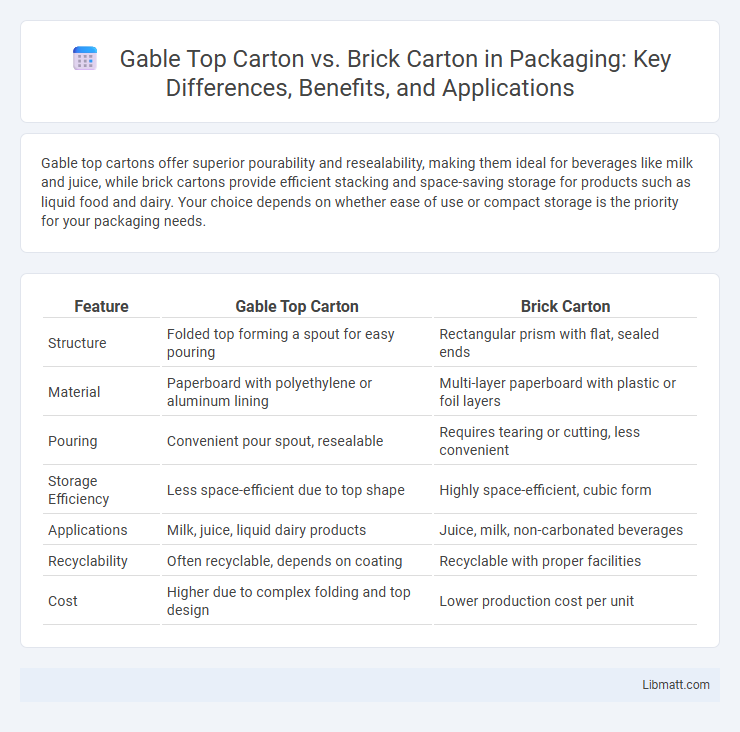Gable top cartons offer superior pourability and resealability, making them ideal for beverages like milk and juice, while brick cartons provide efficient stacking and space-saving storage for products such as liquid food and dairy. Your choice depends on whether ease of use or compact storage is the priority for your packaging needs.
Table of Comparison
| Feature | Gable Top Carton | Brick Carton |
|---|---|---|
| Structure | Folded top forming a spout for easy pouring | Rectangular prism with flat, sealed ends |
| Material | Paperboard with polyethylene or aluminum lining | Multi-layer paperboard with plastic or foil layers |
| Pouring | Convenient pour spout, resealable | Requires tearing or cutting, less convenient |
| Storage Efficiency | Less space-efficient due to top shape | Highly space-efficient, cubic form |
| Applications | Milk, juice, liquid dairy products | Juice, milk, non-carbonated beverages |
| Recyclability | Often recyclable, depends on coating | Recyclable with proper facilities |
| Cost | Higher due to complex folding and top design | Lower production cost per unit |
Introduction to Gable Top and Brick Cartons
Gable top cartons feature a unique roof-like closure that allows easy pouring and resealing, making them ideal for beverages such as milk and juice. Brick cartons have a rectangular, brick-like shape that maximizes storage efficiency and shelf space, commonly used for liquid products in retail. Both packaging types combine paperboard materials with protective layers to preserve product freshness and extend shelf life.
Structural Design Differences
Gable top cartons feature a distinctive peaked roof-like structure with a folded spout for easy pouring, while brick cartons have a rectangular prism shape with a flat top optimized for stacking and storage. The gable design incorporates angled folds that create rigidity and facilitate resealing, contrasting with the brick carton's straightforward, uniform edges that maximize packing density. These structural differences impact both user convenience and logistical efficiency in beverage packaging.
Material Composition and Sustainability
Gable top cartons are primarily made from paperboard coated with polyethylene, offering efficient recyclability and a reduced environmental footprint compared to brick cartons, which typically combine paperboard with a plastic or aluminum lining, complicating recycling efforts. The simpler material composition of gable top cartons enhances sustainability by enabling easier separation and reuse in recycling facilities. Choosing gable top cartons for your packaging needs supports eco-friendly practices by minimizing resource consumption and waste generation.
Packaging Efficiency and Space Utilization
Gable top cartons offer superior packaging efficiency with easy stacking and strong structural integrity, maximizing space utilization during storage and transportation. Brick cartons provide compact, rectangular shapes that minimize wasted space, fitting efficiently on pallets and shelves to optimize inventory management. Choosing between gable top and brick cartons depends on your priorities for handling convenience versus space optimization.
Ease of Opening and Closing
Gable top cartons offer enhanced ease of opening and closing due to their built-in spout or tear strip, allowing smooth pouring and resealing without compromising product freshness. Brick cartons, with their rectangular shape and sealed edges, often require cutting or tearing to open, which can make resealing difficult or impossible, reducing convenience for repeated use. The ergonomic design of gable top cartons significantly improves user experience for beverages and liquid dairy products by facilitating secure and simple access.
Aesthetic and Branding Opportunities
Gable top cartons offer a unique, easily recognizable silhouette that enhances shelf presence and supports premium branding through customizable shapes and printed designs. Brick cartons provide a sleek, uniform surface ideal for high-resolution graphics and consistent brand messaging across various product lines. Choosing the right design can elevate Your product's visual appeal and reinforce brand identity in competitive retail environments.
Compatibility with Different Beverage Types
Gable top cartons excel in packaging dairy products like milk and cream due to their resealable spouts and ease of pouring, while brick cartons are more versatile for various beverages, including juices, plant-based drinks, and liquid food products, thanks to their compact shape and efficient storage design. The gable top design supports beverages requiring aseptic processing and maintains freshness through secure sealing, whereas brick cartons provide cost-effective packaging for high-volume liquid distribution with comparable shelf life. Both carton types accommodate different beverage viscosities and storage requirements, ensuring compatibility across a broad range of liquid consumables.
Manufacturing and Production Costs
Gable top cartons generally have higher manufacturing and production costs due to their complex folding and sealing processes compared to brick cartons, which feature simpler rectangular designs and are easier to mass-produce. The materials used in gable top cartons often require precise cutting and specialized machinery, increasing your overall expenses. Choosing between these cartons impacts your packaging budget, as brick cartons offer a more cost-efficient solution for large-scale production.
Environmental Impact and Recycling
Gable top cartons, commonly used for milk and juice, are primarily made from renewable paperboard with a thin polyethylene coating, making them easier to recycle in facilities equipped for paper recovery. Brick cartons, often used for beverages like juice and non-dairy milk, contain multiple layers of paperboard, polyethylene, and aluminum foil, complicating recycling and requiring specialized processes to separate materials. The environmental impact of gable top cartons tends to be lower due to higher recyclability rates and reduced reliance on aluminum, which is energy-intensive to produce and recycle.
Choosing the Right Carton for Your Product
Gable top cartons offer easy pouring and reclosable features ideal for beverages like milk and juice, enhancing user convenience. Brick cartons provide a compact, stackable design that maximizes storage efficiency and minimizes packaging material for products such as cream or small liquid portions. Selecting the right carton depends on product type, shelf life requirements, and consumer usability preferences to optimize protection and branding.
Gable top carton vs brick carton Infographic

 libmatt.com
libmatt.com